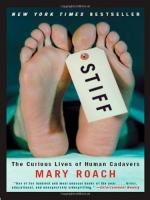
|
| Name: _________________________ | Period: ___________________ |
This test consists of 15 multiple choice questions and 5 short answer questions.
Multiple Choice Questions
1. Why is Shanahan not afraid of air travel?
(a) Because crashes typically happen at takeoff and are survivable.
(b) Because crashes are extremely rare.
(c) Because he has faith in people and their systems.
(d) Because he has to travel a great deal.
2. Who do researchers help with their work at the University of Tennessee?
(a) Cancer research.
(b) Families.
(c) Raw science.
(d) Criminal investigations.
3. How often do families renege on their consent, according to Mike Walsh?
(a) All the time.
(b) Hardly ever.
(c) Not very often.
(d) Often.
4. What do researchers risk if they omit details of their research on cadavers?
(a) Violating ethics laws.
(b) Losing cadavers to work with in the future.
(c) Offending families later.
(d) Perjuring themselves.
5. Why is the British practice for avoiding consent impractical, according to Mary Roach?
(a) Because some research requires whole bodies.
(b) Because it relies on legal sophistries.
(c) Because it raises the cost through litigation from families.
(d) Because it speaks on the cadaver's behalf.
6. How will a person's wounds tell a different story, according to Mary Roach's reading on pathology?
(a) Depending on whether the person was one of the first to be impacted in a crash.
(b) Depending on where they sat in a plane.
(c) Depending on how long it took for a ship to sink.
(d) Depending on whether a plane was bombed or simply crashed.
7. What class does Mary Roach attend in order to talk with surgeons who worked on decapitated heads?
(a) Blunt force damage.
(b) Brain trauma.
(c) Face lift refresher.
(d) Wound repair.
8. Whom does Mary Roach say British surgeons began to dissect, when cadaver supply ran low?
(a) Their students.
(b) Their dead relatives.
(c) Street people.
(d) Animals.
9. How does Mary Roach characterize the third stage of decay in a cadaver?
(a) Bloat with large numbers of maggots.
(b) Persistence of putrescent odor.
(c) Liquidation of internal organs.
(d) Skin sloughing off, with maggots beneath the surface.
10. Who did the 'father of anatomy' dissect?
(a) Executed criminals.
(b) Live criminals.
(c) Unwilling victims.
(d) Disinterred dead people.
11. What have medical schools done in the past decade, according to Mary Roach?
(a) Tried to instill respect for the dead in students.
(b) Tried to compensate families for donating deceased family members.
(c) Tried to develop techniques that allow more students to learn from each civilized.
(d) Tried to increase the rate of people donating their bodies to science.
12. Who did Robert Knox buy corpses from?
(a) Teaching hospitals.
(b) Cemeteries.
(c) Churches.
(d) Murderers.
13. When did injury analysis begin?
(a) 1954.
(b) 1988.
(c) 1968.
(d) 1972.
14. How does Mary Roach characterize the second stage of decay in a cadaver?
(a) Persistence of putrescent odor.
(b) Liquidation of internal organs.
(c) Bloat with large numbers of maggots.
(d) Skin sloughing off, with maggots beneath the surface.
15. Why was it hard for Shanahan to investigate the crash of TWA Flight 800?
(a) The bodies covered a large area.
(b) The bodies were still intact, and lifelike.
(c) There were so many young people on board.
(d) The bodies were unrecognizable.
Short Answer Questions
1. What kinds of injuries have cadavers helped scientists understand?
2. In what field are animals used almost exclusively?
3. How does Mary Roach describe the way the surgeons see the exercise of working on cadavers?
4. What does surgeon Marliena Marignani find difficult to work with?
5. What animals did investigators use to determine cause of death in the British Comet crashes?
|
This section contains 569 words (approx. 2 pages at 300 words per page) |

|




